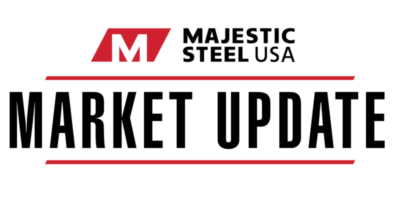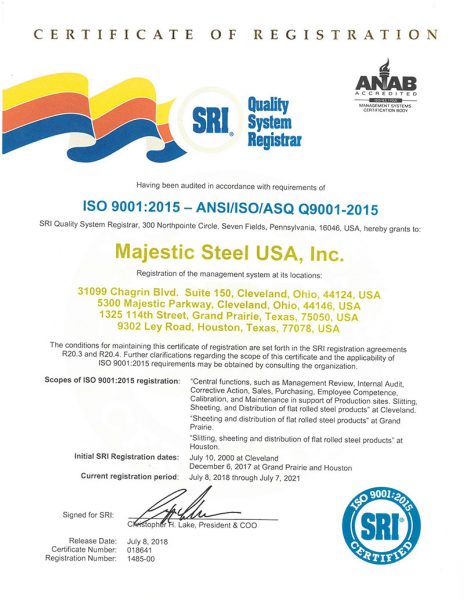Market Update | February 16, 2022
NORTH AMERICAN AUTOMOTIVE DEMAND TO GROW IN 2022
According to original equipment manufacturer, Magna International, North American automotive builds could increase by 2.1 million vehicles in 2022. The company expects builds in North America to grow to 15.2 million, up from their 2021 estimate of 13.1 million. This is still below pre-pandemic levels of 16.3 million vehicles in 2019. Two weeks ago Ford and GM shared similar sentiments as they expect their sales to increase as much as 15% compared to last year.
INPUT COSTS
Zinc pricing remained firm this week after a sharp increase to start the new year, as zinc pricing has now remained over $1.60/lb for forty consecutive readings.
– Zinc pricing remained at or slightly above $1.65/lb this week; holding at that level since the week before Christmas.
– However, longer-term forecasts expect pricing to return to the recent $1.40/lb.-$1.45/lb. average.
Spot iron ore pricing was virtually flat this week, holding at $149.95/dmt.
– While spot iron ore pricing is virtually flat w/w, pricing is still up 19.5% m/m.
Pacific basin met coal pricing continued to climb this week, hitting a fresh all-time high.
– Met coal pricing climbed to $444/mt, up 8.6% from last week.
After falling back sharply from a record high in May of last year, lumber prices have begun to push higher since mid-December.
– Prices are about 22% lower than that peak but still about three times their average pre-pandemic price.
– The National Association of Home Builders estimated the recent price jump added more than $18,600 to the price of a newly built home.
The Baltic Dry Index (BDI), considered the benchmark for bulk ocean freight, saw its largest one-day percentage gain in a year last week.
– The BDI jumped 437 points (15.1%) to 1,940 on Friday, along with the Capesize (+25% to 1,503) and Panamax (+9.2% to 2.153) sub-indices.
– Given Capesize is leading the rally; the surge can be attributed to increased iron ore shipments out of Brazil absorbing freight capacity.
SUPPLY
Domestic raw steel production slipped for the fourth consecutive week last week, sliding below 80% utilization for the first time since early May last year.
– U.S. steelmakers produced 1.758 million tons at a 79.8% utilization rate.
– Year-to-date production is 3.5% above the total from the same period last year.
Based on preliminary import licenses, the daily average import level for February (7 days) is down 10.3% m/m.
– Excluding the volatile Brazilian semi-finished imports, the current pace is down 12.6% m/m.
DEMAND
North American automotive builds could increase by 2.1 million vehicles in 2022, according to original equipment manufacturer (OEM) Magna International.
– The company expects builds in North America to grow to 15.2 million vehicles in 2022, up from its estimate of 13.1 million vehicles in 2021.
– The 2022 production estimate would still be below the pre-pandemic production level for the region of 16.3 million vehicles in 2019.
The February Empire Manufacturing Index came in at 3.1, up from a -0.7 reading in January but remains well below the level from the first half of last year.
– Any reading above 0.0 indicates expansion, while any reading below 0.0 denotes contraction.
– New orders and shipments held steady and unfilled orders increased.
– Looking ahead, while companies expect conditions to improve over the next six months, optimism dipped to its lowest level since mid-2020.
In January, total industrial production increased 1.4%.
– Manufacturing output and mining production rose 0.2% and 1.0%, respectively.
– Total industrial production in January was 4.1% higher than its year-earlier level and 2.1% above its pre-pandemic (February 2020) reading.
– Capacity utilization for the industrial sector increased 1.0% point in January to 77.6%, a rate that is 1.9% points below its long-run (1972–2021) average.
PRICE
According to Platts, HRC pricing around the globe continues to see an uptick.
– Asian HRC prices increased again last week, ending the week at $812/mt.
– This is up 4.1% w/w and 7.8% m/m.
– Spot HRC prices in Northern Europe slipped slightly last week but remain up 4.9% m/m at $1,098/mt.
ECONOMIC
The Cass Truckload Linehaul Index continued to increase in January.
– The Linehaul Index came in at 150.2, up 2.2 points from 148.0 in December.
– Strong freight demand and tight capacity are continuing to push the index higher.
– The Linehaul Index is an indicator of market fluctuations in per-mile truckload pricing.
U.S. retail and food sales for January were $649.8 billion; adjusted for seasonal variation and holiday and trading-day differences, but not for price changes. This is an increase of 3.8% from December and 13.0% above January 2021.
– Total sales for the November 2021 through January 2022 period were up 16.1% from the same period a year ago.
– Compared to December, the largest increases in sales came from furniture stores, online retailers, and automotive dealers.
This material, information and analyses (the “Content”) may include certain statements, estimates and projections prepared with respect to, among other things, historical data and anticipated performance. Content may reflect various assumptions by Majestic Steel USA, Inc. concerning anticipated results that are inherently subject to significant economic, competitive and other uncertainties and contingencies and have been included for illustrative purposes. Content is provided AS-IS.

